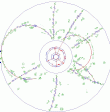 Click on the thumbnail to the left to get a large picture of a
beam's-eye, or end-on, view of the event.
The detectors have cylindrical geometry, so this is a view of the end
of the cylinder.
Data from the two tracking detectors are shown as green points and circles.
Click on the thumbnail to the left to get a large picture of a
beam's-eye, or end-on, view of the event.
The detectors have cylindrical geometry, so this is a view of the end
of the cylinder.
Data from the two tracking detectors are shown as green points and circles. The outer detector is a multi-wire drift chamber. Charged particles traveling through the detector knock electrons off of atoms in the gas filling the chamber. The electrons are amplified and collected on wires strung through the detector pointing into the image. The signals (or "hits") are shown in the image as little green circles. Some of the wires are tilted a little instead of pointing directly into the image. The tilt enables the measurement of the particle trajectory in the dimension perpendicular to the image (shown below). The blue circles show the hits after they have been corrected for the tilt. The trajectories of the particles are circles, rather than straight lines, because the detector is inside a strong magnetic field (0.5 Tesla for this event) pointing into the image. The field strength is about the same as that used in medical imaging devices and is about 10,000 times the earths magnetic field strength in North America. The radius of the circle formed by the particle trajectory is proportional to the momentum of the particle.
The inner detector is the Silicon Vertex Tracker (SVT). It's purpose is to very accurately measure the points at which the particles intersect the planes of the detector. The precision of each data point is between 1/10 and 1/100 th of a millimeter! These measurements enable us to determine where the particle came from to a precision of about 1/10 th of a millimeter.
 Click on the thumbnail to the left to see a side view of the event.
This image shows that the trajectory each particle is a really helix (or
corkscrew). This is because the magnetic field only affects the motion
of the particle which is perpendicular to the direction of the magnetic field.
Click on the thumbnail to the left to see a side view of the event.
This image shows that the trajectory each particle is a really helix (or
corkscrew). This is because the magnetic field only affects the motion
of the particle which is perpendicular to the direction of the magnetic field.